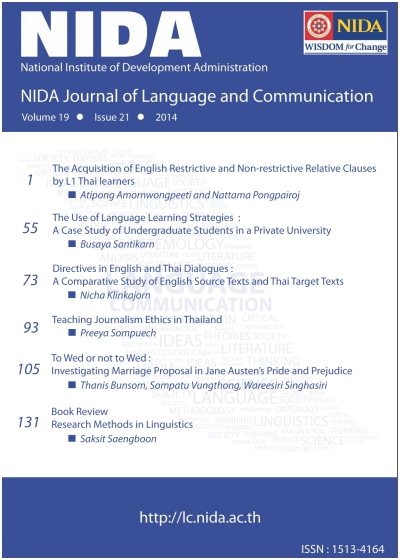The Acquisition of English Restrictive and Non-restrictive Relative Clauses by L1 Thai Learners
Keywords:
English Acquisition, English Restrictive and Non-restrictive Relative Clauses, Noun Phrase Accessibility Hierarchy, Perceptual Difficulty HypothesisAbstract
This study examined the acquisition of English restrictive and non-restrictive relative clauses (RRCs and NRRCs) by L1 Thai learners to test whether the Noun Phrase Accessibility Hierarchy (NPAH) (Keenan & Comrie, 1977) and the Perceptual Difficulty Hypothesis (PDH) (Kuno, 1974), both previously confined to RRC data, would be equally applicable to NRRCs. As the distinction between English RRCs and NRRCs does not rely on the factors upon which the two hypotheses are hinged, it was hypothesized that these hypotheses would be equally applicable to both RC types. However, because NRRCs are less common, the acquisition of NRRCs was hypothesized to diverge from that of RRCs. A sentence interpretation task and a grammaticality judgment task were administered to 40 intermediate and advanced L1 Thai undergraduate students and five native controls. The results showed that RRC and NRRC acquisition trajectories confirmed the NPAH, suggesting the NPAH could also be extended to NRRCs. The PDH, however, seemed to apply to the acquisition of RRCs but not NRRCs, possibly because NNRCs’ prototype differs from RRCs’. The results also demonstrated that the learners experienced more difficulty in acquiring NRRCs than RRCs. This asymmetry was attributed to NRRCs’ rarity and lesser degree of prototypicality, including transfer of training and the cognitive factor of overgeneralization (Selinker, 1972).
Downloads
How to Cite
Issue
Section
License
By submitting a manuscript, the author transfers the copyright for the article to School of Language and Communication, National Institute of Development Administration (NIDA), if and when the manuscript is accepted for publication. Though the journal is an open-access, reproduction of any material published in NIDA Journal of Language and Communication for non-personal and/or commercial purpose requires a written permission from School of Language and Communication, National Institute of Development Administration (NIDA).






